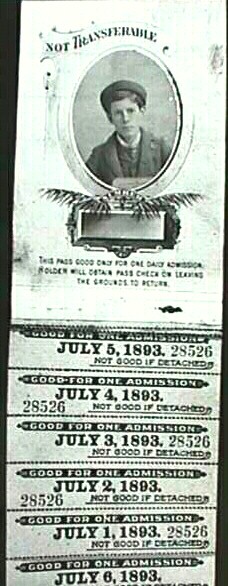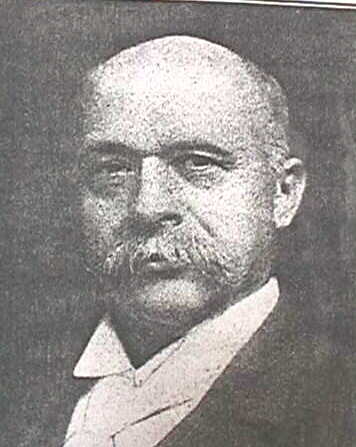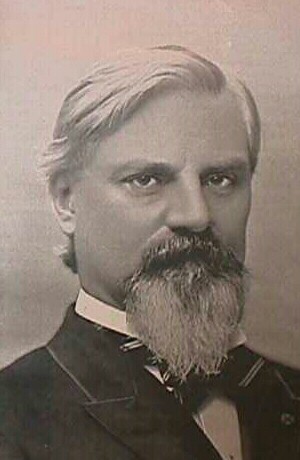| THE COLUMBIAN EXPOSITION
PREFACE
by Thomas G. Yanul - copyright 2001
Exactly
why C.D. Arnold was chosen to be the construction photographer at this Exposition
is not known. Some have stated his being selected was on account of
his "connections" to New York architects, the undertone being that it was
somehow immoral or underhanded. It was not immoral or incorrect. It's
how people make a living, then and now. What is incorrect is to get
the job only because you have contacts and aren't qualified, or do it very
poorly compared to others who tried to get the work. But this absolutely
cannot be said of Arnold. He was a skilled, hard working businessman who
did the job and did it well. He was hired as a construction photographer
after all, not someone to represent the United States of America to the world.
It was a tough, hard, demanding job that apparently was done to the satisfaction
of the man who had hired him - presumably Daniel Burnham. chief of construction
- if it was in fact that personal of a situation. Whether it was a
handshake between these two individuals, or someone on Burnham's construction
staff who was told to get a photographer, the result was the same. How hard
did other photographers try to get that job ? No one knows, and that's all
there is to the argument. We do not know. People can conjecture all they
want. The bottom line is the same. Arnold got the job, and did it apparently
well enough to be in line for the job of "Official Photographer" when
it came along. If that position was even discussed at the outset of
his employment, again, no one knows. Animosity often grows out of resentment,
or a personal grudge or jealousy. There were no rumblings about
Arnold's work that I know of until he became "Official" and then two things
became apparent; one was that it was going to be a lucrative business arrangement
and two, when you begin exercising control over other people there are going
to be conflicts.
The
roots of the Chicago Exposition officially began with a Chicago City Council
meeting and subsequent announcement by Mayor DeWitt C. Cregier on July 22,
1889 of the appointment of a citizen's committee to look into the matter
of holding a world's fair, later expanded by Congress to celebrate
the discovery of America by Christopher Columbus. The short version includes
the appointment of an Executive Committee,and the authorization to sell
stock in the corporation to raise $5-million dollars ( fully subscribed
by 30,000 stockholders as of Apr. 9, 90 ). The preliminary organization ceased
to function with the first meeting of the stockholders on April 4, 1890.
The two most important accomplishments or the early organization had been
the securing of permission from Congress to be the city of choice and secondly,
the raising of funds. With these tasks done the power and planning became
the responsibility of the World's Fair Corporation. The Congress actually
gave its legal approval on April 25, 1890. Former congressman George R. Davis
was among those from the early committee who would later be chosen as
"Director General" for the Federal Commission set up by Congress, ostensibly
to overlook the Federal Governments large contributions to the fair - which
in the end turned out to be construction of a building for themselves and
the minting of $5-million worth of silver half-dollars to be sold as
commemoratives (of which only about half were actually made)- So in effect
the commission was an entity which simply allowed politicians to do favors
by appointing members from the States to its Commission. Ceremonial positions
of stature and of course a politicians main weapon - patronage and/or
publicity.
Director
General George R. Davis had been Chicago's point man in Washington. His role
along with his Federal Committee became somewhat of a thorn in the side of
the corporation. The gentlemen's understanding was that the Federal Commission
would take care of National and international issues - getting other countries
and states to get involved, etc., but the group often attempted to have a
say in matters of the expositions work, which did not sit well with
the Fair's Executive Corporate Committees who paid the bills and did the
day to day planning. the Ways & Means and Grounds & Buildings Committees
met almost daily for three years). The Chicago Corporation was often at odds
with "suggestions" on how to do things with the Federal Committee, who had
contributed little, money-wise, and were part-time "officials". Davis
began to believe that his role as Director General was actually a title of
importance, and Arnold was the subject for his wrath. After all, Arnold was
at the bottom of the totem pole in terms of power and importance.
NOTE:
A Chicago Tribune article dated 3/1/1890 states that C.D. Arnold of
New York is staying at the Palmer House hotel. this is just before the stock
in the Exposition Co. was subscribed for. Arnold is obviously getting his
pitch in
early.
ARNOLD'S
TWO TROUBLEMAKERS
Arnold's
two biggest problems, aside from day to day photo operations, came from two
people - Director General Davis and Frederick C. Beach of New York. One caused
a "problem" of minor proportions because of bad publicity for the fair
- the connection only being that Arnold was the Official Photographer. The
other was also a sort of public matter even though few of the public
were actually concerned. But the matter was stirred by the press and created
discomfort for the Exposition. In the end they stood their ground but
Arnold took a licking in public, without justification as far as this author
is concerned.
Arnold's
problems with Davis came primarily because his Department of Photography
had gotten behind in taking photographs for the press, magazines, newspapers
and the like. The arrangement, as approved by the Ways & Means
Committee, provided that any press or publication that needed photographs
would have to go through Arnold's department, who would intern charge a $5
per picture fee and actually take the photo that was needed. Of course it
fell behind, as everything did at the fair. No one imagined in the beginning
how huge it would become, and also how difficult it would become to manage.
It was simple supply and demand, and Arnold got behind.
Publishers
were screaming to get things done on time, but the sheer overwhelming numbers
of people making demands on the Photography department had turned into a
nightmare - or really a tempest in a teapot. Some of Arnold's
detractors said it was the worst thing that happened to the fair. WELL
! How about the fact that the Exposition had actually gone technically
bankrupt very early in the fair and only the quiet and immediate overnight
pooling of hundreds of thousands of dollars, kept the expo solvent. These
monies came directly from members of the Exposition company's Executive Committee
who wrote unsecured checks for up to $100,000 each. And if you read
a lot of boring minutes of meetings you learn of serious problems for months
of materials not arriving for construction, misplaced displays, no where
to put things, hugh logistical delays and mix-ups. And to say Arnold's
department being late with some photographs to publishers was "the worst
thing to happen to the Exposition ?".give me a break.. What did happen is
that publishers cried to DG Davis after not being able to resolve the situation
through the Expos Committees or President. How do you resolve overwhelming
demand for something, an unforeseen dilemma that literally affected
practically every item of the fair. Arnold's and the publishers problems
were a flea on an elephant - and the poor animal was infested ! So
the press ran to DG Davis , who had pretty much been spurned whenever he
gave advice to the Corporate Committees. He was a Director looking
for something to direct, something to utilize his "great federal powers."
Arnold was chosen to fall on his pitard. And since it was the
press and publishers who were being miffed, they turned to the only thing
they had available, their editorial pages and letters to the editors. They
cranked out how bad Arnold was, how he was ignoring the needs of the press
who wanted the people to see and know what the fair was like through their
publications. (of course they also wanted to sell a few rags and mags
to make a little profit). So DG Davis and his "friends", used their
private forum to put heat on the fair's President and Committees, and that
in turn filtered down to Arnold, and he was told to change the rules. - (rules
made by the Ways & Means Committee to guard investor's money) The
rules were changed to allow papers and magazine publishers and others to
use their own photographers to get their pictures. The fair organizers
still got their fees for the photos, the publishers got their pictures quicker,
and DG Davis could thump his chest about how he had affected change and
straightened things out at the expo. Arnold was the only one who suffered
the consequences. He was low man on the totem pole.
As
to Arnold's other nemeses, it was Frederick Converse Beach. Beach was
the scion of an extended old and powerful New York family. His father
(Alfred Ely) and an uncle published the New York Sun newspaper and owned
the Scientific American Journal among other things. Young Beach was one of
the rich young men who took up the hobby of photography. Many of the so-called
"Amateurs" in photography of that period were wealthy individuals, some of
whom never had to work and simply indulged themselves in this newfangled
medium. They had the time, money, and education. Beach would often
hold "outings" for his newly formed Society of Amateur Photographers, taking
a steam yacht down the Hudson on photographic
expeditions...one
was reported in a photo magazine and told how they stopped over at West Point
Military Academy to have lunch. It was a tough life being an "amateur
photographer". To add a note which might refresh your knowledge of
Alfred Ely Beach; he was the man who thought of the idea of building
a subway in New York City. When his proposal was rejected he went ahead and
built a test subway anyway - under the streets of New York City. That gives
you some indication of who and what the Beach family was all about; wealthy,
powerful, and inclined to want things done their way. Historians who
know about Beach told me that his nature was that it would be done
his way, or not at all. He was not accustomed to being told no. And
this is the personality that came to attack Arnold.
Somewhere
along the line before the expo opened, rules had been adopted by the Ways
& Means Committee that covered camera use on the fair grounds. This was
hardly unprecedented, being a feature of our 1876 Centennial Fair and other
world fairs. It was a means to produce income, like all the other concessions,
to try to pay for the exposition which was after all, a privately funded
event with all investors money at risk. Beach, as one of the founders of
the amateur photographic society and editor of its house organ magazine,
the American Amateur Photographer, got it in his mind that he
was going to champion a cause, that amateur photographers should be allowed
in for free to shoot what they wanted, with whatever they wanted. Beach argued
vehemently, first against the Chicago Corporation but later against Arnold
personally. an easier target I suspect than the financial heavyweights that
made up the Chicago Corporation. It was preferred that allowing amateurs
unfettered access to the fair would advertise the fair to the rest of
the world. Of course the crackerjack Dept. of Publicity and Promotions thought
they already were handling that job quite well thank you. So after
repeated attempts, Beach decided it was Arnold's doing that was keeping the
"amateurs" out of the fair, charging them an outrageous $2 daily fee and
shooting with 4x5" cameras cameras and no tripods. Beach was after
all part of the New York wealthy establishment and that meant he had an ear
of many a newspaper. they raked Arnold over the coals with rancorous editorials
often pulling Beach's own magazine rhetoric and publishing it in their
papers). In some cases a letter to the editor attacking Arnold, would soon
appear as an editorial in another. One wonders at who the originators
of those "letters to the editor" were. Arnold remarked that he had
never even met Beach and couldn't understand his animosity. It was personal,
but one sided. But the rules on hand cameras stood. After all, it was
the Ways & Means who really made the decisions. They knew that in order
to make the fair profitable, or at least break even, they had to garner money
from any place they could. And in the end, it was the concessions that made
the fair a financial success. Arnold was simply a cog in the wheel
- and also one of the few people involved with the expo who had a dual role:
he was both a private entrepreneur with the concession to sell photographs,
and also an employee of the Commission required to make a photographic record
of the fair. It was two-hat affair which I assume took some delicate
political balancing. Beach's rancor lasted for many months but pretty much
died away after the editorship of the Club's magazine was taken over by Aflred
Stieglitz in July,1993. Stieglitz may not have like the situation either
but for him it was not a cause-celeb as it had
been
for Beach.
Although
a considerable amount of record material is available, much is missing,
especially the specific details. Published records of the committees often
relate only final decisions, not the intricate details of the hows and
whys, only the wherefores. So conjecture runs rampant on why something was,
or was not done. We can only make educated guesses about a great many things
dealing with the exposition. But that's the stuff of history. Some modern
social historians have read grand social phenomena into Arnold's photographs.
I call that story telling, not historical professionalism.
I
will simply try to tell what I know about Arnold's operation as a business
and as a professional photographer hired to do a job - a monumental task
that no one person could have envisioned.
|
|
ED NOTE: Oct.14, 2002
I
have recently come across
an
interesting article from Wilson's
Photographics
Magazine, dated
March
1913, where W.I. Lincoln Adams, noted photography writer
wrote
about Arnold and the reason
he
was choosen as official photog at the 1893 Expo.
To read it go here.
Employees
of concessions were issued
a
photo pass with daily tear off stubs.
The
pass photos were made by J.J. Gibson,
Official
Portrait Photographer.
This
person is Samuel Thomas,
Saleslady, Photography Dept.
(I
assume its a mistake in gender identification - the name and photo appear
to be a young man)


FREDERICK CONVERSE BEACH

Director General "Colonial
Geo. R. Davis" From Campbell's
World's Columbian Exposition
IllustratedVol.1, No.2 March 1891
Campbell wrote a glowing account of Davis
as follows:
"The subject of the frontispiece, Col.
Geo. R. Davis the Director General of the World's Fair and the man on whose
broad shoulders rests the chief responsibility of the conduct of that
stupendous undertaking"
[
that statement must have sat well with the Columbian Exposition Corporation
!]
General
Notes on the Official Photographer
by photo & other magazines.
As
has already been stated to some degree, F.C. Beach, as editor of the American
Amateur
Photographer
magazine was consistently
lambasting
Arnold and fair authorities because of their stance against free and
open use of any cameras by Amateur photographers.
Beach
simply did not want any restrictions.
His
harangue continued for more than a year.
Other
publications were sympathetic to Beach, and re-published much his scathing
editorial material in their magazine. These included
the
Photo Beacon and to a lesser extent, The St.Louis & Canadian
Photographer.
Notably
absent of vitriolic verbiage were The Photographic Times, edited by W.I.Lincoln
Adams, and Wilson's Photographic Magazine, by Edward L. Wilson. It should
be remembered that both Wilson and Adams had been involved in the concession
of the Centennial Expo of 1876, and were both loath to assign blame for having
the concession.
They
knew is was a business, and realized that with that came conflicts. Both
these men
were
very diplomatic in their reporting on Arnold's and the Exposition's problems
regards hand cameras, amateur photographers and
the
like. Both men were businessmen and photographers, unlike Beach whose
livelihood
was
secure the day he was born.
Inland
Architect seemed to favor Arnold's views
very
much and printed many in its editions, with little or no comment about the
various controversies. Engineering Record seemed to
follow
Beach and printed several of his scathing
editorials.
Next Page: The Columbian Exposition
Construction phase
TO CONTACT: |


